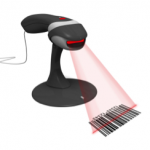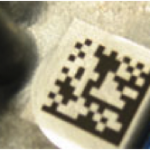 Barcodes—that little pattern of lines and spaces—first burst onto the American scene in 1974, on a pack of Wrigley Spearmint gum in a grocery store in Troy, Ohio. By 1990 barcodes had become so important, the American National Standards Institute (ANSI) published a specification for printed barcode quality.
Barcodes—that little pattern of lines and spaces—first burst onto the American scene in 1974, on a pack of Wrigley Spearmint gum in a grocery store in Troy, Ohio. By 1990 barcodes had become so important, the American National Standards Institute (ANSI) published a specification for printed barcode quality.
WHAT IS BARCODE QUALITY?
What does barcode quality actually mean? Is barcode quality limited to the printed image or does it include the structure of the encoded data? What if the printed image and data structure are accurate but the data encode the wrong item or no item at all?
 In the early days, poorly performing barcodes were an inconvenience at the checkout line, but today bad barcodes can destroy the integrity of a supply chain, jeopardize the security of the food and pharmaceutical safety system, and cause bedside drug dosing errors in hospitals and other health care facilities.
In the early days, poorly performing barcodes were an inconvenience at the checkout line, but today bad barcodes can destroy the integrity of a supply chain, jeopardize the security of the food and pharmaceutical safety system, and cause bedside drug dosing errors in hospitals and other health care facilities.
Barcode quality seems like a simple issue. Even today some people denigrate the use of a verifier in favor of using a scanner to “test” barcode quality—if they use anything at all. And there are devices sold as verifiers that cannot be certified to comply with the specification that qualifies them to test barcodes—and yet some people buy them to do just that.
Devices that only partially test barcode quality, or do not test them in accordance with international standards cause a concern about what barcode quality actually means.
 PROBLEMS WITH BARCODES
PROBLEMS WITH BARCODES
These factors and others have contributed to ongoing problems with barcodes, and this is likely a factor in driving a change in how barcode quality will be defined in the future. Barcode quality is a more important issue as barcode technology has been adopted into more critical roles where mistakes could have dire consequences.
Newer barcodes have higher data storage capacity, allowing barcodes to perform mini-database functions not possible a few years ago. With this ability, barcodes can identify people—for example our personal information is encoded in a 2D barcode on the back of most drivers’ licenses. Barcodes will play a major role in the movement toward electronic medical records. The consequences of errors in these applications will be important and potentially ominous.
 EMERGENCE OF BARCODE RISK
EMERGENCE OF BARCODE RISK
The net effect of this is a focus on risk as the primary characteristic of barcode quality. What is the magnitude of the risk when a barcode fails for whatever reason—poor print quality, poor data construction, incorrect data, packaging errors, etc? All of these (and more) contribute to barcode quality—each is necessary but none are sufficient to encompass all of barcode quality by themselves. They are all attributes in a larger system. When any one of them fails, there is risk. That is what will define barcode quality in the future.
A negative view of redefining risk as the primary characteristic of barcode quality is to conclude that it is all about blame. A more helpful view is to see risk assessment as a tool for exposing attitudes and practices that do not serve the quest for barcode quality. In truth the ISO standard for quality of the printed barcode image and the ISO compliance standard for the verifier have not been sufficient control the risk of barcode quality problems.
 The movement toward a risk-based redefinition of quality is larger than barcode technology. Risk management has long been a visible concern of the manufacturing sector—perhaps the most visible being the automotive and consumer products manufacturing and their highly publicized product recalls. Risk management is the business bedrock beneath the insurance industry.
The movement toward a risk-based redefinition of quality is larger than barcode technology. Risk management has long been a visible concern of the manufacturing sector—perhaps the most visible being the automotive and consumer products manufacturing and their highly publicized product recalls. Risk management is the business bedrock beneath the insurance industry.
But increasingly, risk is gaining recognition as a primary concern of virtually every other business, not just business tools such as software and organizational leadership and supervision, but also businesses processes such as logistics and product movement security.
The positive view of redefining quality as risk points to the positive ramifications this has for competitiveness. When we get this right, the U.S. will be leading the global business community into a new paradigm where quality can compete with low price—and win.
Bio:
John is a GS1 Certified Bar Code Professional, a greatly respected, nationally recognized barcode quality expert, presenter, instructor and author of Bar Code Quality Step By Step, a highly acclaimed eBook available at Barcode-Test.com.
John launched Barcode-Test LLC to help brand owners, contract printers, consumer and healthcare packaging companies, stored value card and loyalty card manufacturers, retailers and others to manage bar code quality-related risk and liability
Barcode-Test offers independent ISO-compliance testing for linear bar codes and 2D symbols and bar code quality seminars.
Specialties: Making bar code quality, a highly technical subject understandable, relevant and interesting.